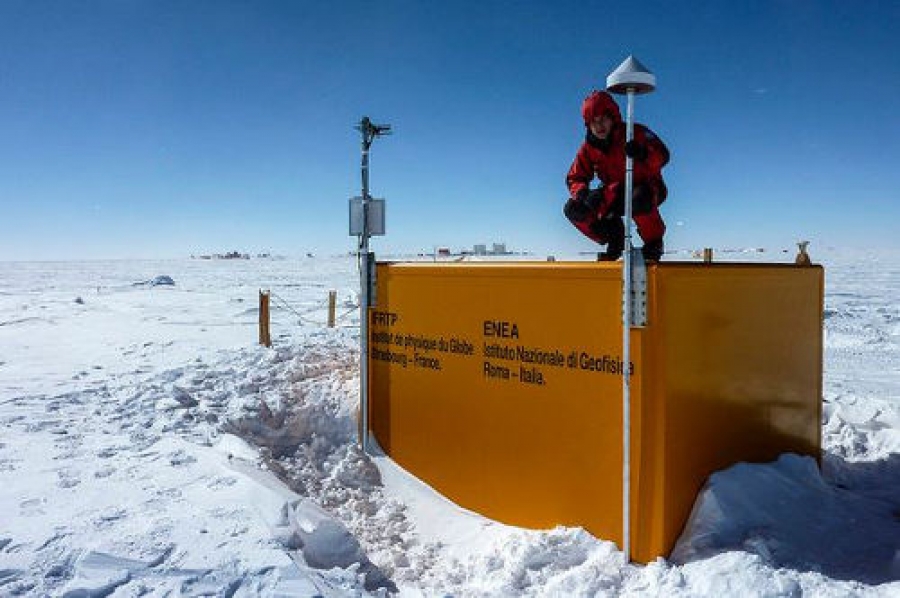Do winter weather conditions have an effect on the accuracy and use of mass-market GNSS devices? To find out, the European GNSS Agency (GSA) asked the experts working in Antarctica.
The holidays are over and all we are left with is another couple of  months of cold, wet and foggy winter weather. And there’s nothing worse than having to travel in winter weather conditions. Whether it’s walking to a meeting or driving across town, at least you can depend on global navigation satellite systems (GNSS), including Galileo, to help guide you to your destination along the most efficient route possible. All you have to do is plug the coordinates into your smartphone or in-vehicle navigation device, bundle up and head out – letting GNSS take care of the rest.
months of cold, wet and foggy winter weather. And there’s nothing worse than having to travel in winter weather conditions. Whether it’s walking to a meeting or driving across town, at least you can depend on global navigation satellite systems (GNSS), including Galileo, to help guide you to your destination along the most efficient route possible. All you have to do is plug the coordinates into your smartphone or in-vehicle navigation device, bundle up and head out – letting GNSS take care of the rest.
This is of course assuming that GNSS isn’t affected by the rain, snow, fog and dense clouds that define winter in much of Europe. After all, if the satellite signals are delayed or unable to reach the receiver in your device, you might just find yourself left out in the cold!
To get to the bottom of this, we asked some experts about the effect, if any, that the winter weather has on your use of GNSS devices.
Navigate like a penguin
If you really want to see how winter weather impacts the use of GNSS, there’s really no better place to conduct your research than Antarctica. Nicola Umberto, a researcher at Politecnico di Torino, recently travelled there to install a GNSS monitoring station – one of the first researchers to collect Galileo signals at high (and very cold) latitudes.
The DemoGRAPE project, funded by the Italian National Program for Research in Antarctica (PRNA), is a new prototype of support for satellite navigation in Antarctica. It includes an installed GNSS monitoring system at two research bases, which monitor the ionosphere behaviour, or space weather, over the continent and how it effects satellite signals. The project is being carried out in cooperation with the Italian Institute of Geophysics and Vulcanology, the South African Space Agency and the Brazilian Space Agency, with the support of the European Commission’s Joint Research Centre (JRC).
“The accuracy of satellite navigation in Antarctica is of paramount importance, both for logistic and for scientific purposes,” says Umberto. “There is always the danger that people and vehicles can fall into a crevasse during a snowstorm, when visibility is limited and travel is restricted to specified routes.”
GNSS high-precision applications in Antarctica – such as geodetic prospecting, land and glacier monitoring and airport traffic management – can be threatened by ionospheric scintillations, a physical phenomenon very similar to the one producing aurora. “Unfortunately, scintillations damage satellite signals, introducing amplitude and phase variations, which in turn impacts the quality and reliability of the position,” explains Fabio Dovis, a professor at Politecnico di Torino who is also involved with the project. “DemoGRAPE has contributed to the understanding of these threats to GNSS applications in polar regions and proposed new methods for optimising scientific and technological achievements.”
Granted most of us won’t be navigating through quite such extreme conditions, although at some point in the middle of February it might very well feel like we’re living in Antarctica. Nonetheless, the DemoGRAPE project’s findings are applicable to our everyday use of GNSS for navigating in more ‘normal’ winter weather conditions. “As so often happens in science, results of experiments in particular conditions, such as Antarctica, can be exploited to better understand and characterise general phenomena,” adds Umberto.
Let it snow, let it snow, let it snow!
According to the experts, weather does not have a visible effect on GNSS. After all, GNSS was built to serve as an all-weather, 24/7 navigation tool. Furthermore, the vast majority of GNSS hardware currently on the market is built to operate in conditions down to -40 degrees Celsius; also the equipment is stored inside ground stations – with only an antenna mounted outside – meaning they protect against the most extreme levels of cold.
“What this means is a mass-market user will not experience any effects during winter weather,” says S2Ds Navigation and GNSS Data Science Fellow at Nottingham University Lukasz Bonenberg. “That being said, work in the high-precision sector, where centimetre level accuracy is required, can be affected by space weather.”
However, unless you’re a farmer using precision agriculture to tend to a field in the middle of winter, you probably won’t see any weather-related effects on your use of GNSS for basic navigation. Even if you do, for some reason, find yourself working a snow-covered field in February, you should be fine – as the effects of space weather are primarily confined to the Earth’s poles.
In other words, regardless of how snowy or cold it is outside, you can’t use ‘my GNSS is frozen’ as an excuse for not making that appointment!
Media note: This feature can be republished without charge provided the European GNSS Agency (GSA) is acknowledged as the source at the top or the bottom of the story. You must request permission before you use any of the photographs on the site. If you republish, we would be grateful if you could link back to the GSA website (http://www.gsa.europa.eu).